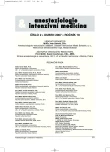The benefits of BIS monitoring during sevoflurane anaesthesia in children
Authors:
J. Capková; B. Komanová; K. Spodník; J. Firment
Authors‘ workplace:
1. klinika anestéziológie a intenzívnej medicíny, LF UPJŠ a FNLP Košice, Slovenská republika
Published in:
Anest. intenziv. Med., 18, 2007, č. 2, s. 65-72
Category:
Anaesthesiology - Original Paper
Overview
Objective:
To compare BIS values during standardized sevoflurane anaesthesia in children with end-tidal sevoflurane concentration, haemodynamic parameters and the speed of recovery.
Design:
Clinical prospective observational study.
Setting:
Department of Anaesthesiology and Intensive Medicine, Faculty of Medicine of P. J. Šafárik University, Košice, Slovakia.
Materials and methods:
96 children scheduled for elective surgery under general anaesthesia were included in the study. They were divided into 2 age groups (1–3 and 3–15 years of age). The anaesthesia protocol included i.v. induction and maintenance with sevoflurane. Sevoflurane concentration was adjusted according to MAC, movement to painful stimuli and vegetative signs.
Results:
In both the age groups BIS values showed a correlation with end-tidal sevoflurane concentration (r= -0.51–0.58, p < 0.01). In the 3–15yrs group there was a correlation between sevoflurane concentration and MAP (r= -0.45, p < 0.01). In both the age groups the times till awakening were significantly longer in the subgroup of children with perioperative BIS < 60 compared to the subgroup with BIS > 60 (age group 1–3 yrs: 45.8 ± 27 min vs. 35.1 ± 23 min, p < 0.05, age group 3–15yrs: 40.8 ± 17 vs. 18.1 ± 12 min, p < 0.001).
Conclusion:
In children aged 1–15 years of age the end-tidal concentration of sevoflurane correlated closer with BIS than with MAP and did not correlate with the heart rate. Children with perioperative BIS < 60 awakened later than children with BIS > 60.
Key words:
paediatric anaesthesia – bispectral index – sevoflurane
Labels
Anaesthesiology, Resuscitation and Inten Intensive Care MedicineArticle was published in
Anaesthesiology and Intensive Care Medicine

2007 Issue 2
Most read in this issue
- Oxygen toxicity in the course of hyperbaric oxygenotherapy
- Postintubation tracheal rupture – a case report
- Anaesthesiology and resuscitation in The Central Army Hospital in Prague (1948–1972)
- The benefits of BIS monitoring during sevoflurane anaesthesia in children
